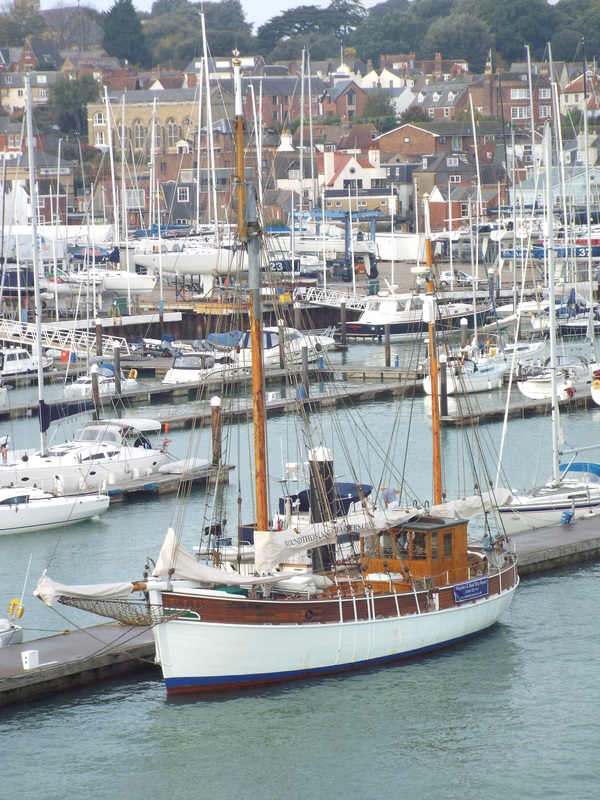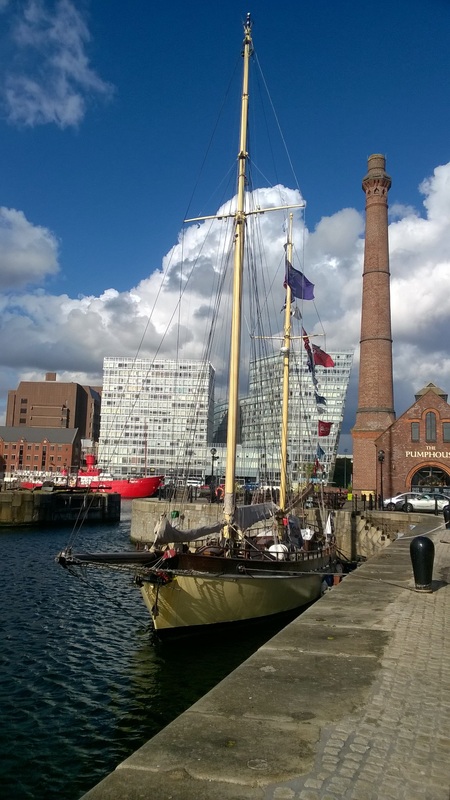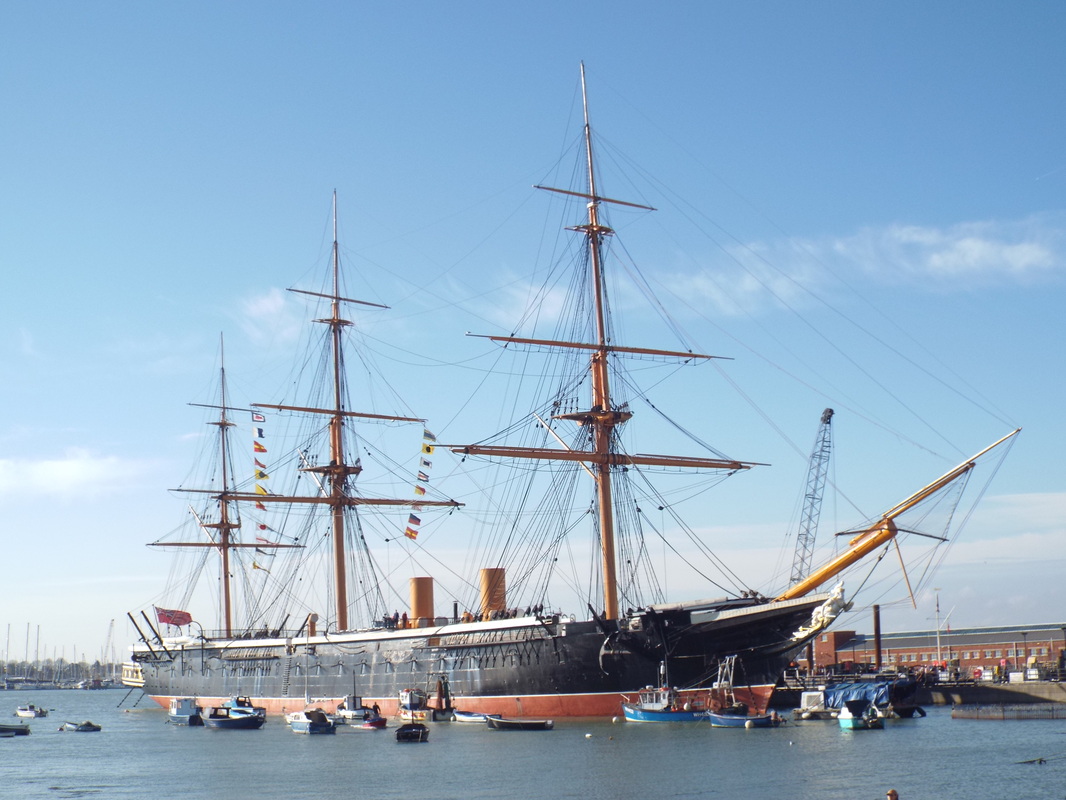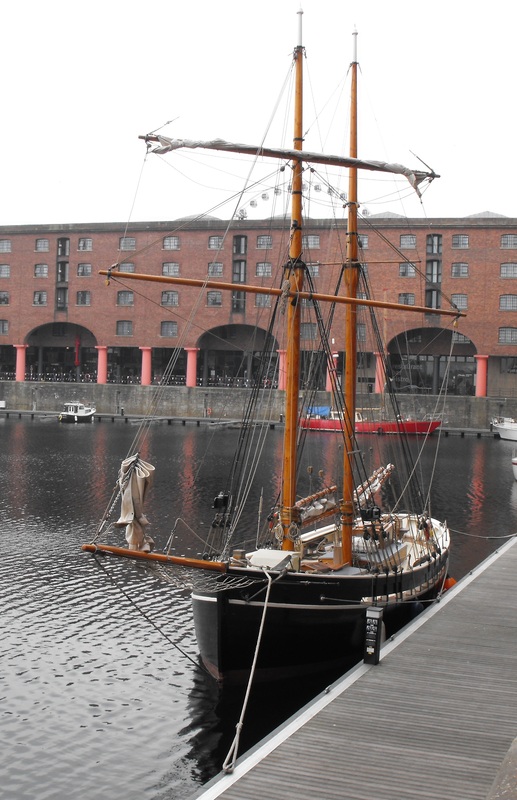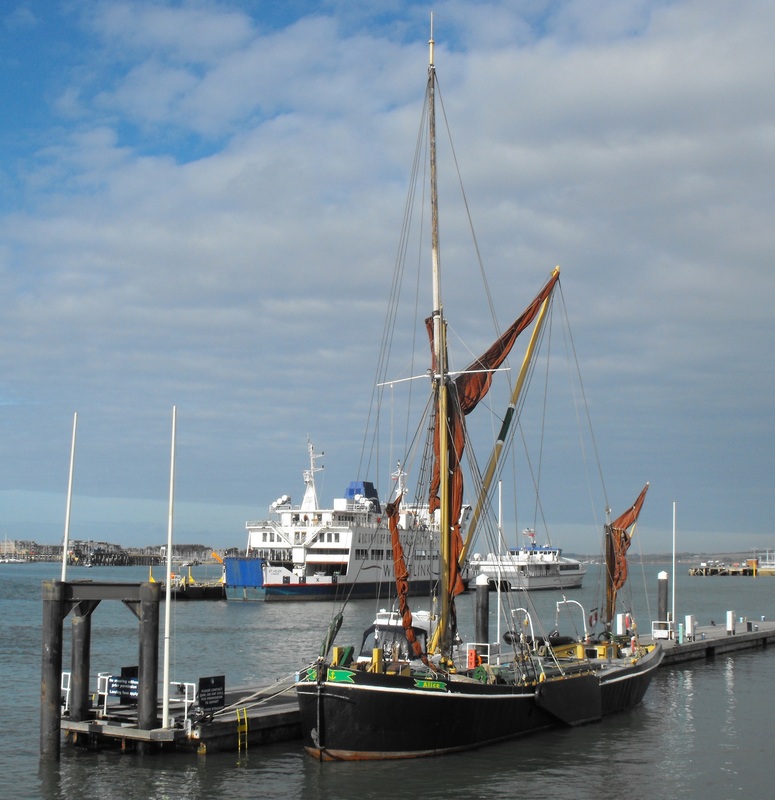STAVROS N NIARCHOS
Sail Training vessel Stavros N Niarchos photographed near the Albert Dock in Liverpool on 14 November 2014.
The ship was built in Appledore in 2000 on a hull that had been constructed in Germany. The naval Architects were Burness, Corlett and Partners and the rig was designed by sail training expert Michael Willoughby.
The vessel has ten square rigged sails, seven staysails and a spanker giving a a total sail area of 949m2. Both masts have steel lowers and timber top masts reaching 36.5m above the water.
Accommodation is provided for 67 in 5 double, 6 single 1 three berth and 6 dormitories with 8 pipe-cot berths. She has two deck houses, one containing the wheelhouse, masters cabin and wardroom, the other containing the galley, pantry and mess room which provided service for 48 people.
Two 333kw Mercedes MTU auxillary engines power the brig to 9 knots via two controllable pitch propellers.She also has a single 90kw bow thruster.
The hull is divided into six watertight compartments.
GT = 493 and NT = 198
At the time of writing she is up for sale in the commercial market for £2.95m.
MMSI - 232007330
REG - UK, London
IMO - 9222314
Call Sign - MZIU7
Sail Training Ship
Built - Abeking & Rasmussen, lemwerder, DE (Hull only)
Yard Number - 6442
L = 59.33 W = 9.88
GT = 493
Year - 2000
Liverpool, 14 November 2014
The ship was built in Appledore in 2000 on a hull that had been constructed in Germany. The naval Architects were Burness, Corlett and Partners and the rig was designed by sail training expert Michael Willoughby.
The vessel has ten square rigged sails, seven staysails and a spanker giving a a total sail area of 949m2. Both masts have steel lowers and timber top masts reaching 36.5m above the water.
Accommodation is provided for 67 in 5 double, 6 single 1 three berth and 6 dormitories with 8 pipe-cot berths. She has two deck houses, one containing the wheelhouse, masters cabin and wardroom, the other containing the galley, pantry and mess room which provided service for 48 people.
Two 333kw Mercedes MTU auxillary engines power the brig to 9 knots via two controllable pitch propellers.She also has a single 90kw bow thruster.
The hull is divided into six watertight compartments.
GT = 493 and NT = 198
At the time of writing she is up for sale in the commercial market for £2.95m.
MMSI - 232007330
REG - UK, London
IMO - 9222314
Call Sign - MZIU7
Sail Training Ship
Built - Abeking & Rasmussen, lemwerder, DE (Hull only)
Yard Number - 6442
L = 59.33 W = 9.88
GT = 493
Year - 2000
Liverpool, 14 November 2014
URSULA - 1953
Ursula photographed in Cowes on 31 October 2015. She was built in 1953 at Sakuth, Heiligenhafen, Germany, a small fishing port on the Baltic Coast. It is believed Ursula was built as a cadet training ship but may have also played a part in the Cold War with sophisticated sonar and listening equipment originally installed on board.
Built to a traditional design with oak planking on oak frames, Ursula withstood the harsh Baltic conditions for many years, with lead ingots packed into the bow area for ice breaking.
After a major refit in the mid 1990's, Ursula spent 10 years operating in the Scottish Hebrides, carrying passengers on whale watching trips. During this time she was named 'Solais Na Mara' .
Overall she is 23.3m long with a 5.68m beam and 2.40m draft.
Sail area is 153m3.
Max speed 10 knots.
Gross Tonnage: 99.5 and DWT = 54.
Accommodation on board caters for 11 crew in 3 cabins, including 2 doubles.
Main Engine is a 250hp Perkins Sabre M215C.
Built to a traditional design with oak planking on oak frames, Ursula withstood the harsh Baltic conditions for many years, with lead ingots packed into the bow area for ice breaking.
After a major refit in the mid 1990's, Ursula spent 10 years operating in the Scottish Hebrides, carrying passengers on whale watching trips. During this time she was named 'Solais Na Mara' .
Overall she is 23.3m long with a 5.68m beam and 2.40m draft.
Sail area is 153m3.
Max speed 10 knots.
Gross Tonnage: 99.5 and DWT = 54.
Accommodation on board caters for 11 crew in 3 cabins, including 2 doubles.
Main Engine is a 250hp Perkins Sabre M215C.
JEANIe johnsTON
Jeanie Johnston photographed in Dublin during our day trip to the City on 11 November 2015.
She is a replica of a three masted barque of the same name that was originally built in Quebec, Canada, in 1847 by the Scottish-born shipbuilder John Mumm.
The original Jeanie Johnston was bought by merchant John Donovan & Sons as a cargo vessel and traded successfully between Tralee and North America for a number of years. The trading pattern was to take emigrants from Ireland to North America and then to bring timber back to Europe.
She made her maiden emigrant voyage from Blennerville, Co. Kerry to Quebec on 24 April 1848, with 193 emigrants on board. Between 1848 and 1855 she made 16 voyages to North America, sailing to Quebec, Baltimore and New York.
On average the length of the transatlantic journey was 47 days. The most passengers she ever carried was 254 from Tralee to Quebec on 17 April 1852.
Despite the number of passengers and the long voyage, no crew or passengers lives were ever lost on board. This is generally attributed to the captain James Atteridge not overloading the ship and the presence of a qualified doctor on board for the benefit of the passengers.
In 1855 the ship was sold to William Johnson of North Shields, England. In 1858 whilst sailing to Quebec from Hull with a cargo of timber she became waterlogged. The crew climbed into the rigging and after nine days clinging to their slowly sinking ship they were all safely rescued by a Dutch ship the Sophie Elizabeth.
The replica vessel was built in Blennervile at a cost of 13.7m Euro's which included the cost of the shipyard, workshops and visitors centre. She was laid down in 1998, launched on 6 May 2000 and undertook her maiden voyage in March 2003,
Overall she is 47m long with a 8m beam and 4.6m draft.
Her hull is constructed of larch planks on oak frames. The decks were constructed from Iroko and Douglas Fir with Douglas Fir masts and spars,
She has 18 sails with at total area of 6,940m2 and also has twin 290hp (216kW) Caterpillar 3306 diesel engines and a single 50kW bow thruster.
MMSI - 250271000
IMO - 8633671
Call Sign - EIJL
L = 47 W = 8m
GT 301
Built - 2002
She is a replica of a three masted barque of the same name that was originally built in Quebec, Canada, in 1847 by the Scottish-born shipbuilder John Mumm.
The original Jeanie Johnston was bought by merchant John Donovan & Sons as a cargo vessel and traded successfully between Tralee and North America for a number of years. The trading pattern was to take emigrants from Ireland to North America and then to bring timber back to Europe.
She made her maiden emigrant voyage from Blennerville, Co. Kerry to Quebec on 24 April 1848, with 193 emigrants on board. Between 1848 and 1855 she made 16 voyages to North America, sailing to Quebec, Baltimore and New York.
On average the length of the transatlantic journey was 47 days. The most passengers she ever carried was 254 from Tralee to Quebec on 17 April 1852.
Despite the number of passengers and the long voyage, no crew or passengers lives were ever lost on board. This is generally attributed to the captain James Atteridge not overloading the ship and the presence of a qualified doctor on board for the benefit of the passengers.
In 1855 the ship was sold to William Johnson of North Shields, England. In 1858 whilst sailing to Quebec from Hull with a cargo of timber she became waterlogged. The crew climbed into the rigging and after nine days clinging to their slowly sinking ship they were all safely rescued by a Dutch ship the Sophie Elizabeth.
The replica vessel was built in Blennervile at a cost of 13.7m Euro's which included the cost of the shipyard, workshops and visitors centre. She was laid down in 1998, launched on 6 May 2000 and undertook her maiden voyage in March 2003,
Overall she is 47m long with a 8m beam and 4.6m draft.
Her hull is constructed of larch planks on oak frames. The decks were constructed from Iroko and Douglas Fir with Douglas Fir masts and spars,
She has 18 sails with at total area of 6,940m2 and also has twin 290hp (216kW) Caterpillar 3306 diesel engines and a single 50kW bow thruster.
MMSI - 250271000
IMO - 8633671
Call Sign - EIJL
L = 47 W = 8m
GT 301
Built - 2002
GLACIERE OF LIVERPOOL - 1899
Glaciere photographed in the Albert Dock, Liverpool on 29 April 2015.
She is a 1899 built Baltic Trader once used to carry stone between England and Denmark.
The Glaciere was recovered as wreckage from the bed of Liverpool's Collingwood Dock in 2003 and restored to her former glory in six months by a team of volunteers.
She is a 1899 built Baltic Trader once used to carry stone between England and Denmark.
The Glaciere was recovered as wreckage from the bed of Liverpool's Collingwood Dock in 2003 and restored to her former glory in six months by a team of volunteers.
MAYBE - 1929
Maybe is a traditional Dutch sailing ketch built in 1929 and was designed by her original owner Jan Jacob van Rietschoten to sail around the world with his family.
She was built in Amsterdam by the De Vries Lentsch ship yard with steel frames and teak planking.
During the Second World War the vessel was taken to the Dutch town of Jutplaces where she was hidden in a remote backwater. After the War she was completely restored by the yard that built her but with a new rig replacing her original gaff rig. In 1956 she took part in the first ever Tall Ships race.
In 1962 she was sold to Swiss owners where she sailed around the Mediterranean, in the 1970's she made many crossings across the Atlantic between the West Indies and Mediterranean ports and in the 1980's she sailed through the Panama Canal and up the East coast of the USA to Canada.
Sold to her current owners in 1989 she was completely restored with her original gaff rig and returned to sailing in 2007.
Overall she is 22m long (+ bowsprit) with a 6m beam and 3.2m draught. Her tallest mast is 25.7m high.
Complement is 16 crew members.
She now operates as a Sail Training ship.
Photographed just North of the Albert Dock in Liverpool on 29 April 2015.
MMSI - 235062552
Call Sign - 2ASG3
She was built in Amsterdam by the De Vries Lentsch ship yard with steel frames and teak planking.
During the Second World War the vessel was taken to the Dutch town of Jutplaces where she was hidden in a remote backwater. After the War she was completely restored by the yard that built her but with a new rig replacing her original gaff rig. In 1956 she took part in the first ever Tall Ships race.
In 1962 she was sold to Swiss owners where she sailed around the Mediterranean, in the 1970's she made many crossings across the Atlantic between the West Indies and Mediterranean ports and in the 1980's she sailed through the Panama Canal and up the East coast of the USA to Canada.
Sold to her current owners in 1989 she was completely restored with her original gaff rig and returned to sailing in 2007.
Overall she is 22m long (+ bowsprit) with a 6m beam and 3.2m draught. Her tallest mast is 25.7m high.
Complement is 16 crew members.
She now operates as a Sail Training ship.
Photographed just North of the Albert Dock in Liverpool on 29 April 2015.
MMSI - 235062552
Call Sign - 2ASG3
HMS WARRIOR - 1860
HMS Warrior photographed in Portsmouth on 28 October 2014.
I have visited and explored the ship on a couple of occasions in the past and she is well worth a visit.
The brainchild of Admiral Baldwin Walker she was designed by Isaac Watts who was the Royal Navy's chief constructor, the idea was to build a ship that was more heavily armoured, faster and better armed than anything then afloat.
Built at a cost of £390,000 at the Thames Ironworks in Blackwall, London her keel was laid in May 1859, she was launched on 28 December 1860 before being ready for her first commission on 1 August 1860.
Warrior boasted steam powered engines and 48,400 square feet of sale and was equipped with a propeller that could be disengaged and lifted out of the water to stop it dragging when Warrior was under sail power. She was also fitted with telescopic funnels that could be lowered when required to allow the sails to batter catch the wind.
She is 127m long with a 18m beam and 8m draught and her hull consists of 16mm planking to which was fastened 460mm of teak which was then covered with 110mm of wrought iron plate.
She could reach speeds of 13 Knots under sail and 14.5 knots under steam power.
Armament consisted of 26 muzzle loading 68 pounder guns and 10 breach loading 110 pounder guns
She had a complement of 705 officers and men comprising 42 Officers, 3 Warrant Officers, 455 Seamen and boys, 33 Royal Marine Officers, 6 Royal Marine NCO's, 118 Royal Marie Artillerymen, 2 Chief Engineers, 10 Engineers and 66 Stokers and Trimmers.
Charles Dickens described her as 'A black vicious ugly customer as ever I saw, whale like in size and with a terrible row of incisor teeth as ever closed on a French Frigate'.
Although she never fired a shot in anger she spent some time leading the Channel Squadron patrolling home waters, with however the rapid development in warship and engine design at the time she was by 1871 overtaken by HMS Devastation which was a mast less battleship. Following a three and a half year refit she started naval and coastguard duties and on 14 May 1883 entered Portsmouth for the last time under her own power having sailed some 90,000 miles during her career at sea.
In 1902 she became a mothership to Portsmouth's torpedo boats and in 1904 became part of HMS Vernon's torpedo training school.
In 1923 however she was paid off and offered for sale and in 1929 was towed to Milford Haven where she was used as a floating oil jetty.
In 1976 a plan was put together to restore her and she was towed to Hartlepool in 1979 where the work was carried out.
On 16 June 1987 she returned to Portsmouth.
I have visited and explored the ship on a couple of occasions in the past and she is well worth a visit.
The brainchild of Admiral Baldwin Walker she was designed by Isaac Watts who was the Royal Navy's chief constructor, the idea was to build a ship that was more heavily armoured, faster and better armed than anything then afloat.
Built at a cost of £390,000 at the Thames Ironworks in Blackwall, London her keel was laid in May 1859, she was launched on 28 December 1860 before being ready for her first commission on 1 August 1860.
Warrior boasted steam powered engines and 48,400 square feet of sale and was equipped with a propeller that could be disengaged and lifted out of the water to stop it dragging when Warrior was under sail power. She was also fitted with telescopic funnels that could be lowered when required to allow the sails to batter catch the wind.
She is 127m long with a 18m beam and 8m draught and her hull consists of 16mm planking to which was fastened 460mm of teak which was then covered with 110mm of wrought iron plate.
She could reach speeds of 13 Knots under sail and 14.5 knots under steam power.
Armament consisted of 26 muzzle loading 68 pounder guns and 10 breach loading 110 pounder guns
She had a complement of 705 officers and men comprising 42 Officers, 3 Warrant Officers, 455 Seamen and boys, 33 Royal Marine Officers, 6 Royal Marine NCO's, 118 Royal Marie Artillerymen, 2 Chief Engineers, 10 Engineers and 66 Stokers and Trimmers.
Charles Dickens described her as 'A black vicious ugly customer as ever I saw, whale like in size and with a terrible row of incisor teeth as ever closed on a French Frigate'.
Although she never fired a shot in anger she spent some time leading the Channel Squadron patrolling home waters, with however the rapid development in warship and engine design at the time she was by 1871 overtaken by HMS Devastation which was a mast less battleship. Following a three and a half year refit she started naval and coastguard duties and on 14 May 1883 entered Portsmouth for the last time under her own power having sailed some 90,000 miles during her career at sea.
In 1902 she became a mothership to Portsmouth's torpedo boats and in 1904 became part of HMS Vernon's torpedo training school.
In 1923 however she was paid off and offered for sale and in 1929 was towed to Milford Haven where she was used as a floating oil jetty.
In 1976 a plan was put together to restore her and she was towed to Hartlepool in 1979 where the work was carried out.
On 16 June 1987 she returned to Portsmouth.
VIlMA - 1934
Vilma photographed in the Albert Dock, Liverpool on 27 July 2013.
She was built in 1934 by the Bronsodde Shipyard in Vejle, Denmark as a gillnet fishing boat.
Originally she had a low ketch rig and a 2 cylinder diesel engine and was named Mias, she was registered as RI100 and her homeport was Hvide Sande.
She was bought by her present owner in 1996 from Silloth in Cumbria who converted her to a topsail schooner. Her home port is now Bangor in North Wales and she is registered in Beaumaris.
She is Licenced MCA cat 2 to carry 12 people and is in demand to participate in maritime festivals on both sides of the Irish Sea.
My thanks to Vilma's owner for kindly providing the above information.
She was built in 1934 by the Bronsodde Shipyard in Vejle, Denmark as a gillnet fishing boat.
Originally she had a low ketch rig and a 2 cylinder diesel engine and was named Mias, she was registered as RI100 and her homeport was Hvide Sande.
She was bought by her present owner in 1996 from Silloth in Cumbria who converted her to a topsail schooner. Her home port is now Bangor in North Wales and she is registered in Beaumaris.
She is Licenced MCA cat 2 to carry 12 people and is in demand to participate in maritime festivals on both sides of the Irish Sea.
My thanks to Vilma's owner for kindly providing the above information.
KALTHLEEN AND MAY - 1900
Kathleen and May is a wooden hulled topsail schooner built at Connah's Quay in North Wales in 1900 by Ferguson & Baird. She was built for Captain John Coppack who was a leading ship owner and was originally named Lizzie and May after his two daughters.
With a length of 29.98m, a 7.06m beam and 2.59m draught she was designed to carry a cargo of 226 tons, her planks were 75mm thick pitch pine laid on double oak frames and secured with nails and iron bolts
She operated as a trading schooner until 1961 and regularly sailed around the British coastline delivering a variety of cargos between Liverpool, Cardiff, Ireland, Scotland, the Channel Islands and West Country.
Accommodation on board consisted of a fo'c'sle that could house four hands and two small cabins for the mate and Captain which were located off the saloon which also acted as the mess room.
Her first commercial voyage was under the command of Captain Tom Hughes and was from Connah's Quay to Rochester with 226 tons of fire bricks, she then carried cement to Plymouth, pitch to Cardiff, coal to Falmouth and clay to Weston Point, by 1908 she had sailed nearly 40,000 nautical miles
In 1908 she was bought by MJ Fleming of Youghal in Southern Ireland and renamed Kathleen and May after his daughters. She operated between the Bristol Channel and Ireland importing coal whilst often carrying oats or pit props on the outward journey.
During World War I she carried coal and other vital resources to small ports around the country.
In 1931 she purchased by a Captain Jewell who shortened her top mast and fitted an 80hp engine. In World War 2 she was operated by the Ministry of Defence to carry gun powder and was equipped with a machine gun on her foredeck.
In 1945 Captain Jewell died leaving her to his son who continued to operate her until 1961 after which she had a number of owners before retiring in 1967, she has subsequently been restored.
MMSI - 235036333
Call Sign - MDNN
Photographed in Liverpool, 22 August 2013.
With a length of 29.98m, a 7.06m beam and 2.59m draught she was designed to carry a cargo of 226 tons, her planks were 75mm thick pitch pine laid on double oak frames and secured with nails and iron bolts
She operated as a trading schooner until 1961 and regularly sailed around the British coastline delivering a variety of cargos between Liverpool, Cardiff, Ireland, Scotland, the Channel Islands and West Country.
Accommodation on board consisted of a fo'c'sle that could house four hands and two small cabins for the mate and Captain which were located off the saloon which also acted as the mess room.
Her first commercial voyage was under the command of Captain Tom Hughes and was from Connah's Quay to Rochester with 226 tons of fire bricks, she then carried cement to Plymouth, pitch to Cardiff, coal to Falmouth and clay to Weston Point, by 1908 she had sailed nearly 40,000 nautical miles
In 1908 she was bought by MJ Fleming of Youghal in Southern Ireland and renamed Kathleen and May after his daughters. She operated between the Bristol Channel and Ireland importing coal whilst often carrying oats or pit props on the outward journey.
During World War I she carried coal and other vital resources to small ports around the country.
In 1931 she purchased by a Captain Jewell who shortened her top mast and fitted an 80hp engine. In World War 2 she was operated by the Ministry of Defence to carry gun powder and was equipped with a machine gun on her foredeck.
In 1945 Captain Jewell died leaving her to his son who continued to operate her until 1961 after which she had a number of owners before retiring in 1967, she has subsequently been restored.
MMSI - 235036333
Call Sign - MDNN
Photographed in Liverpool, 22 August 2013.
ALICE - 1954
Built by James W.Cook & Co. at Wivenhoe in 1954 Alice was originally built as a lighter, to be rowed, or towed, to and from the River Lea to the Lower Pool of London.
In 1994 Alice was removed from trade and over the next few years completely reconstructed and converted to a Thames sailing barge, this reconstruction was completed in 1998.
In 2005 she had a new 125hp Ford diesel fitted.
She is now moored and available for charter near the Gun Wharf Marina complex in Portsmouth where I took the above photograph.
She has a length of 23.5m with 5.5m beam and 1.1m draft. Sails consist of the mainsail, topsail, mizzen; foresail, plus stays and total approximately 3,500 sq.ft.
Accommodation is now provided below deck in a main saloon which includes a galley/bar and dining for 20 seated guests. She also has four 2-berth cabins and a single 3-berth cabin in addition to separate crew quarters.
Photographed Portsmouth, 30 October 2013.
In 1994 Alice was removed from trade and over the next few years completely reconstructed and converted to a Thames sailing barge, this reconstruction was completed in 1998.
In 2005 she had a new 125hp Ford diesel fitted.
She is now moored and available for charter near the Gun Wharf Marina complex in Portsmouth where I took the above photograph.
She has a length of 23.5m with 5.5m beam and 1.1m draft. Sails consist of the mainsail, topsail, mizzen; foresail, plus stays and total approximately 3,500 sq.ft.
Accommodation is now provided below deck in a main saloon which includes a galley/bar and dining for 20 seated guests. She also has four 2-berth cabins and a single 3-berth cabin in addition to separate crew quarters.
Photographed Portsmouth, 30 October 2013.
SPIRIT OF FAIRBRIDGE
Photographed 10 July 2013 heading out of the River Mersey Spirit of Fairbridge is a replica of a Mersey pilot schooner.
She is operated by a company called Fairbridge who as part of their young persons development programme take up to 12 young people at a time from all over the UK to sea. Built as a gaff schooner by Merseyside Trust she has a hull constructed of oak frames and larch planks. Length overall is 28m with a 5.1m beam and 3.4m draft. Mast height is 26m.
She has a Mermaid Manta II 140hp engine which enables her to make 8 knots, accommodation consists of 6 staff berths and 12 crew berths.
MMSI - 232003794
REG - UK, Oban
IMO - 1004106
Call Sign -
Sail Training Ship
Built - Merseyside Trust, UK
Yard No.
L 28m W 5.1m
GT 81
Year - 1985
Liverpool, 10 July 2013
She is operated by a company called Fairbridge who as part of their young persons development programme take up to 12 young people at a time from all over the UK to sea. Built as a gaff schooner by Merseyside Trust she has a hull constructed of oak frames and larch planks. Length overall is 28m with a 5.1m beam and 3.4m draft. Mast height is 26m.
She has a Mermaid Manta II 140hp engine which enables her to make 8 knots, accommodation consists of 6 staff berths and 12 crew berths.
MMSI - 232003794
REG - UK, Oban
IMO - 1004106
Call Sign -
Sail Training Ship
Built - Merseyside Trust, UK
Yard No.
L 28m W 5.1m
GT 81
Year - 1985
Liverpool, 10 July 2013
pelican of london - 1948

One of five identical ships built by Chantiers et Ateliers, Lyon, France in 1948 Pelican was originally a double-beam Arctic fishing trawler.
In 1968 she was reclassified from a trawler to a coaster and renamed Kadett remaining as Kadett until 1995
when she again changed hands when she was bought by ex-Naval Commander Graham Neilson who transformed her into a tall ship.
She is constructed of steel (below the main deck 10mm thick and above the main deck and bulwarks 6mm thick) has a length of 45.0m, beam of 7.03m and 2.95m daught with a GT 226.
She is currently operated as a sail training vessel.
Seen and photographed next to the Albert Dock Liverpool, 14 May 2013.
In 1968 she was reclassified from a trawler to a coaster and renamed Kadett remaining as Kadett until 1995
when she again changed hands when she was bought by ex-Naval Commander Graham Neilson who transformed her into a tall ship.
She is constructed of steel (below the main deck 10mm thick and above the main deck and bulwarks 6mm thick) has a length of 45.0m, beam of 7.03m and 2.95m daught with a GT 226.
She is currently operated as a sail training vessel.
Seen and photographed next to the Albert Dock Liverpool, 14 May 2013.
DE WADDEN - 1917

De Wadden is a three-masted auxiliary schooner built in 1917 by Gehr Van Diepen of Waterhuizen in the Netherlands. Ordered by the Netherland Steamship Company with two sister ships she was built to take advantage of lucrative trading conditions created by Dutch neutrality in the First World War.
During the world-wide shipping slump in the early 1920s she was sold to Richard Hall of Arklow in Ireland and between 1922 and 1961 she carried a multitude of different cargos between Liverpool and Irish Ports.
During World War Two she was one of a small handful of vessels which provided supplies to the Irish Republic after many other ships had been taken up for the British war effort. Her crew consisted of only five men and a boy, and since she could sail, a qualified marine engineer was not required. She carried a motor winch in the forward deckhouse to allow the cargo to be handled in ports with very limited facilities.
Her original 125 hp 'SteyWal Dutch engine gave her a speed of five knots, but after a major failure was replaced by an 80hp Bolinder engine purchased from the Admiralty. In addition a 50 hp Kelvin engine was fitted on the port quarter to give additional power. These were both removed in January 1942 and replaced with a six cylinder 150 hp Crossley DR diesel which was only replaced by a modern engine in 1980
During the world-wide shipping slump in the early 1920s she was sold to Richard Hall of Arklow in Ireland and between 1922 and 1961 she carried a multitude of different cargos between Liverpool and Irish Ports.
During World War Two she was one of a small handful of vessels which provided supplies to the Irish Republic after many other ships had been taken up for the British war effort. Her crew consisted of only five men and a boy, and since she could sail, a qualified marine engineer was not required. She carried a motor winch in the forward deckhouse to allow the cargo to be handled in ports with very limited facilities.
Her original 125 hp 'SteyWal Dutch engine gave her a speed of five knots, but after a major failure was replaced by an 80hp Bolinder engine purchased from the Admiralty. In addition a 50 hp Kelvin engine was fitted on the port quarter to give additional power. These were both removed in January 1942 and replaced with a six cylinder 150 hp Crossley DR diesel which was only replaced by a modern engine in 1980
JOHANNA LUCRETIA - 1945
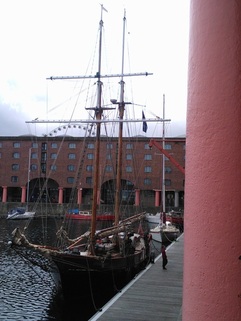
The tall ship Johanna Lucretia.
She is a two masted schooner built at the Rhoos Shipyard, Ghent, Belgium in 1945.
Built from Oak with an Iroko deck and Douglas fir masts she measures 96ft (28.65m) in length with a beam of 18 ft (5.50m) and draught of 8 ft 2.45m). She has a total sail area of 380 m2 and NT of 50.75 Although originally built as a fishing vessel she was converted for recreational use in 1954. She sailed in Dutch waters from her home port in Enkhuizen until 1989 when she was sold and transferred to her new base in Plymouth.
During 1992 she was refitted at the Tommy Nielson Yard in Gloucester and used for charter sailing to the Caribbean, European and US ports. After languishing in Gloucester docks for some time she was restored between 2008 and 2010.
glaciere - 1899, Ruth - 1914 & Zebu - 1938

Closest to the camera is the Glaciere a 1899 built Baltic Trader once used to carry stone between England and Denmark. The Glaciere was recovered as wreckage from the bed of Liverpool's Collingwood Dock in 2003 and restored to its former glory in six months by a team of volunteers.
Second in line is Ruth a Gaff Rigged Baltc Trader built in 1914 by the RAA Ship Yard in Sweden. Constructed from Pitch Pine over an Oak frame she has a length of 28m, draft of 2.2m and 51 GRT.
Final ship in the line up is the Zebu a Fore and Aft Ketch built in 1938 by AB Holmes in Sweden and launched as the Ziba. Until 1972 she was used in the transport of wood, grain and salt before passing into private hands. She has a length of 31m, width of 6.1m and a draft of 2.3m.
Second in line is Ruth a Gaff Rigged Baltc Trader built in 1914 by the RAA Ship Yard in Sweden. Constructed from Pitch Pine over an Oak frame she has a length of 28m, draft of 2.2m and 51 GRT.
Final ship in the line up is the Zebu a Fore and Aft Ketch built in 1938 by AB Holmes in Sweden and launched as the Ziba. Until 1972 she was used in the transport of wood, grain and salt before passing into private hands. She has a length of 31m, width of 6.1m and a draft of 2.3m.

